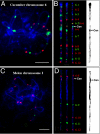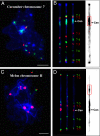Centromere repositioning in cucurbit species: implication of the genomic impact from centromere activation and inactivation
- PMID: 19706458
- PMCID: PMC2736423
- DOI: 10.1073/pnas.0904833106
Centromere repositioning in cucurbit species: implication of the genomic impact from centromere activation and inactivation
Abstract
The centromere of an eukaryotic chromosome can move to a new position during evolution, which may result in a major alteration of the chromosome morphology and karyotype. This centromere repositioning phenomenon has been extensively documented in mammalian species and was implicated to play an important role in mammalian genome evolution. Here we report a centromere repositioning event in plant species. Comparative fluorescence in situ hybridization mapping using common sets of fosmid clones between two pairs of cucumber (Cucumis sativus L.) and melon (Cucumis melo L.) chromosomes revealed changes in centromere positions during evolution. Pachytene chromosome analysis revealed that the current centromeres of all four cucumber and melon chromosomes are associated with distinct pericentromeric heterochromatin. Interestingly, inactivation of a centromere in the original centromeric region was associated with a loss or erosion of its affixed pericentromeric heterochromatin. Thus, both centromere activation and inactivation in cucurbit species were associated with a gain/loss of a large amount of pericentromeric heterochromatin.
Conflict of interest statement
The authors declare no conflict of interest.
Figures




Similar articles
-
Molecular cytogenetic mapping of Cucumis sativus and C. melo using highly repetitive DNA sequences.Chromosome Res. 2010 Apr;18(3):325-36. doi: 10.1007/s10577-010-9116-0. Epub 2010 Mar 3. Chromosome Res. 2010. PMID: 20198418
-
Chromosomal structures and repetitive sequences divergence in Cucumis species revealed by comparative cytogenetic mapping.BMC Genomics. 2015 Sep 25;16(1):730. doi: 10.1186/s12864-015-1877-6. BMC Genomics. 2015. PMID: 26407707 Free PMC article.
-
Karyotyping in melon (Cucumis melo L.) by cross-species fosmid fluorescence in situ hybridization.Cytogenet Genome Res. 2010 Jul;129(1-3):241-9. doi: 10.1159/000314343. Epub 2010 Jun 11. Cytogenet Genome Res. 2010. PMID: 20551614
-
Satellite DNA in Plants: More than Just Rubbish.Cytogenet Genome Res. 2015;146(2):153-170. doi: 10.1159/000437008. Epub 2015 Jul 18. Cytogenet Genome Res. 2015. PMID: 26202574 Review.
-
Organization and evolution of highly repeated satellite DNA sequences in plant chromosomes.Cytogenet Genome Res. 2005;109(1-3):15-26. doi: 10.1159/000082377. Cytogenet Genome Res. 2005. PMID: 15753554 Review.
Cited by
-
Genome-wide characterization of simple sequence repeats in cucumber (Cucumis sativus L.).BMC Genomics. 2010 Oct 15;11:569. doi: 10.1186/1471-2164-11-569. BMC Genomics. 2010. PMID: 20950470 Free PMC article.
-
Fast diploidization in close mesopolyploid relatives of Arabidopsis.Plant Cell. 2010 Jul;22(7):2277-90. doi: 10.1105/tpc.110.074526. Epub 2010 Jul 16. Plant Cell. 2010. PMID: 20639445 Free PMC article.
-
Cytogenetic comparison of heteromorphic and homomorphic sex chromosomes in Coccinia (Cucurbitaceae) points to sex chromosome turnover.Chromosome Res. 2017 Jun;25(2):191-200. doi: 10.1007/s10577-017-9555-y. Epub 2017 Mar 25. Chromosome Res. 2017. PMID: 28343268
-
Karyotyping of commercial cultivars of melon (Cucumis melo L.).Mol Biol Rep. 2022 Nov;49(11):10279-10292. doi: 10.1007/s11033-022-07520-z. Epub 2022 Sep 12. Mol Biol Rep. 2022. PMID: 36097123
-
The epigenetic regulation of centromeres and telomeres in plants and animals.Comp Cytogenet. 2020 Jul 7;14(2):265-311. doi: 10.3897/CompCytogen.v14i2.51895. eCollection 2020. Comp Cytogenet. 2020. PMID: 32733650 Free PMC article. Review.
References
-
- Williams BC, Murphy TD, Goldberg ML, Karpen GH. Neocentromere activity of structurally acentric mini-chromosomes in Drosophila. Nat Genet. 1998;18:30–37. - PubMed
Publication types
MeSH terms
Substances
LinkOut - more resources
Full Text Sources

